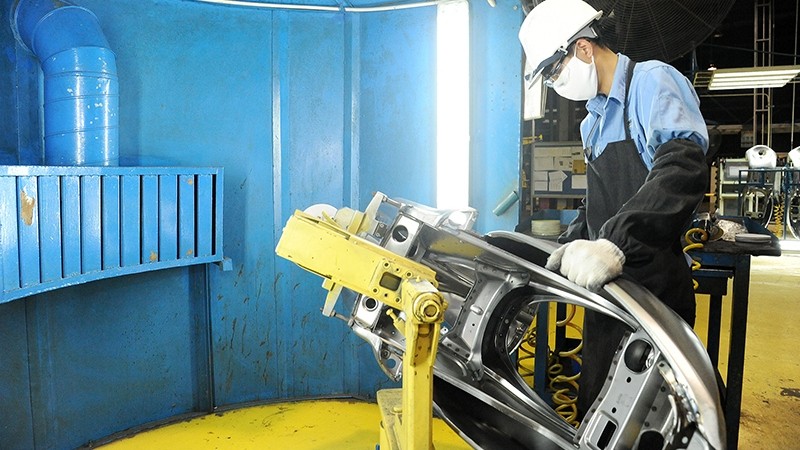A number of industries show recovery
GSO General Director Nguyen Thi Huong said that Vietnam’s GDP was estimated to have expanded 2.12% in the first nine months of this year, the lowest level in the 2011-2020 period but it demonstrated the great success of Vietnam in the context of the serious impacts of the coronavirus pandemic on all aspects of the economy.
Notably, GDP in the third quarter of 2020 expanded by 2.62%, a higher level compared to the second quarter due to recovery in some economic sectors including manufacturing, food processing, paper production, chemistry, rubber and plastic production.
Head of the GSO’s National Account System Department Duong Manh Hung said that the agricultural sector was the brightest spot in the Vietnamese economy in the third quarter of 2020 thanks to high growth in a number of agricultural sectors. Manufacturing rose by 4.6%, lower than the growth rate of the same period in the last five years, but still contributing 1.02 percentage points to the overall growth.
Some sectors, including electronic products, medical equipment and medicines also showed positive growth. In particular, the food and food processing industry increased over 10% in the third quarter of this year, contributing to both job creation and boosting the economy.
Despite the disruptions to global trade due to the COVID-19 pandemic, Vietnam posted a trade surplus of US$3.5 billion in September and a record trade surplus of nearly US$17 billion in nine months, nearly double that of the same period in 2019.
The domestic economic sector has become the motivation for export growth with total export revenue in nine months rising by 20.2%, accounting for 35.4% of the nation’s total export revenue.
After a period of negative growth, total retail sales of goods and services in September increased compared to the previous month and the same period last year while the transportation sector saw a 6.8% increase in the number of passengers and 4.5% increase in the volume of cargo in September compared to the previous month.
The disbursement of public investment has not yet reached the expected level, but the disbursement growth rate has reached the highest level in the past five years, becoming one of the important driving forces fostering economic growth.
Director of the GSO’s Industrial Statistics Department Pham Dinh Thuy emphasised that the disbursement of public investment in the nine months only reached 59.7% of the plan, but that it is accelerating very quickly.
Public investment is mainly focused on key socio-economic infrastructure projects, so when this capital is released, it will attract capital from the private and foreign direct investment sectors, contributing to increasing total investment capital for social development and maintaining economic growth at a reasonable rate.
Focusing on supporting the business community
From the results achieved over the past nine months, the GSO assesses that Vietnam's economic growth target of 2% - 3% in 2020 as forecast by many domestic and foreign research organisations is feasible.
The main driving force for economic growth is still the promotion of disbursement of public investment with a target of disbursing 95% - 97% of the planned capital and also the promotion of manufacturing industry.
In addition, the gradual recovery of the world economy is forecast to increase demand for goods, thereby supporting Vietnam’s economic growth. The coming into force of the EU-Vietnam Free Trade Agreement (EVFTA) is also expected to help Vietnam restore export activities to established European markets.
Moreover, favourable weather for cultivation, good harvests of many kinds of fruit trees, stable prices of rice, the stable consumption market of some agricultural products, and the effective rebuilding of hog herds are factors fuelling agricultural and forestry development.
Over the past four weeks, Vietnam has not detected any new COVID-19 infections in the community while several international air routes have been restored, opening up recovery opportunities for the transport, tourism, hotel and restaurant sectors and contributing to promoting economic growth.
According to the GSO, Vietnam's economy will soon restore itself in the remaining months of 2020 and is likely to bounce back from 2021 on with GDP growth estimated at about 6.5% - 6.7% in 2021 thanks to good financial performance and improvements to public debts, Government debt, borrowing costs, and foreign exchange reserves.
In order to achieve the dual goal of preventing the pandemic while boosting socio-economic growth, the GSO proposes the Government implement six main groups of solutions.
The agency emphasises the significance of the implementation of a large and effective enough support package to remove difficulties for production and business and promote economic recovery with the focus on the business community because they contribute about 60% of GDP growth.
Meanwhile, only VND13 trillion of the relief package worth VND62 trillion in support of people and businesses has been disbursed, mainly to employees, but businesses are finding it hard to approach the package due to its complicated procedures.
The GSO also proposed the acceleration of the disbursement of public investment, particularly key large-scale projects to make a breakthrough in infrastructure in a bid to create another driver for economic growth.
In addition, it is necessary to stimulate investment in production to proactively prepare materials for export as markets around the world reopen while taking advantage of opportunities from the EVFTA.
The GSO also suggested the issuance of appropriate policies to encourage the import of machinery and equipment to expand production while restricting the import of goods that can be produced domestically.
Besides these, the Government and enterprises should study solutions regarding institutions, human resources, production processes, technologies and business strategies to take advantage of the provisions of the EVFTA and EU-Vietnam Investment Protection Agreement (EVIPA).
















